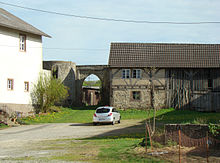Seligental Monastery
The former monastery Seligental located in Baden-Wuerttemberg in Neckar-Odenwald-Kreis between the towns Schlierstadt and rooms , in the district of the city Osterburken . It was founded in 1236 and dissolved in 1568. Remnants of the former monastery complex were recently preserved and preserved for posterity in the farm estate, which is used for agriculture today.
history
The former monastery was a Cistercian nunnery . According to a deed of foundation dated November 25, 1236, the monastery was founded by Konrad von Dürn and his wife Mechthild von Lauffen for aristocratic women. The monastery was located in the middle of the dominion of the Lords of Dürn and was probably also planned as a house monastery and a proper burial place for the donors. The first abbess was named Hildeburgis and was probably a daughter of the founder. The ecclesiastical responsibility for the monastery was held by the diocese of Würzburg . The monastery church was dedicated to St. Consecrated Mother of God. The nuns in Seligental lived according to the rules of St. Benedict of Nursia ( Regula Benedicti ) in the Cistercian form.
To equip the monastery, Konrad von Dürn had withdrawn property in Schlierstadt , Seckach , Zimmer and Hemsbach from the nunnery on the Frankenberg near Amorbach and given it to Seligental. A judgment of the Pope later restituted the Amorbach Monastery. From the donations of the Franconian nobility, whose widows and daughters lived in Seligental, the monastery nevertheless came into possession of goods in the named places as well as in Ruchsen . The monastery villages were not only subject to taxes, but also benefited. a. through the Maundy Thursday Foundation , which existed until 1845 and distributed porridge, and of course through the hospice for the elderly, the sick and the infirm. In addition, the devotion to Mary in the monastery with its secondary patrons Ursula and Nikolaus, to which pilgrimages also took place, shaped religious life in the monastery villages.
The foreign trade of the monastery was handled by the Bronnbach monastery , whose respective abbot was also the father abbot of the Seligental monastery.
After the Dürner family died out, the lords of Hohenlohe became patrons of the monastery, the bishops of Würzburg in 1328, and then Kurmainz in 1505.
Raids during the Peasants' War and the conversion of numerous noble families in the area to the Reformation contributed to the decline of the monastery. The last abbesses included Walpurga von Hardheim, who issued village regulations in 1519 and 1526 and was able to prevent the peasants from destroying the monastery during the Peasants' War, as well as Cäcilia Rüdt von Collenberg, who stood out as a secular abbess when the Reformation came up. In 1552 the monastery was ravaged by marauding soldiers during the Markgräflerkrieg . The times of war and the advancing Reformation left a lack of new entrants. When Abbess Amalia Schelmin von Bergen died in 1561, there were only two nuns left. The monastery was finally dissolved in 1568 and transferred to the Mainz court chamber.
Attempts by the abbots of Ebrach and Salem to revive the convent in 1613 failed due to the resistance of the Archbishop of Mainz. In 1803 Seligental came to the Principality of Leiningen in the course of secularization .
The monastery church was used for church services until the 18th century and was profaned in 1788. It later served as a sheepfold and barn before it burned down in 1928. Its early Gothic entrance portal is still used today as a garden gate. Only the sacristy, which was still used as a chapel until 1848, is recognizable in its original dimensions with ribbed vaults , remains of frescoes and a window in Romanesque shapes.
Seligental has been largely privately owned since 1934 and is used for agriculture.
Pasture border
The delimitation of the “twice broken pasture” of the Seligental monastery was indicated by stone crosses with the symbol of a shepherd's shovel in the head part. Six of these stone crosses were still standing in the 1930s. The last of these crosses was saved from destruction by being set up at the St. Sebastian Church in Seckach in the Neckar-Odenwald district .
literature
- Claudia Baer-Schneider, Claudia Mohn: The former Cistercian convent Seligental in Osterburken-Schlierstadt (Neckar-Odenwald district). But a case for the preservation of monuments. In: Preservation of Monuments in Baden-Württemberg , Volume 37, 2008, Issue 3, pp. 150–155 ( PDF )
- Walter Koupil: Seligental. Schlierstadt building land. Chronicle of a forgotten monastery . 1990
- Elmar Weiß: The Seligental Monastery near Osterburken . Special print to commemorate the foundation of the monastery 750 years ago. 1986.
- Elmar Weiß, Helmut Neumaier: History of the city of Osterburken . Self-published by the city of Osterburken. June 1986. p. 488ff.
- Elmar Weiß: On the history of the Seligental monastery . In: Württembergisch Franken 72 , 1988, pp. 73/74.
- Ute Fahrbach: Seligental Monastery - not a case for monument preservation? In: Preservation of monuments in Baden-Württemberg , 24th year 1995, issue 3, pp. 99–110. ( PDF )
Web links
- Cistercian abbey Seligental in the database of monasteries in Baden-Württemberg of the Baden-Württemberg State Archives
Individual evidence
- ^ Wather Möller: Family Tables of West German Aristocratic families in the Middle Ages . Vol. 3 = Manfred Dreiss (Hrsg.): Library of Classical Works of Genealogy Vol. 2.3. Darmstadt 1936. ND: Neustadt an der Aisch 1996, plate 119.
- ↑ Gebhard Schmitt: The old stone crosses on the Seckacher district. Only one specimen is reminiscent of the former pasture border. In: Our country. Home calendar for Neckar Valley, Odenwald, building land and Kraichgau . 2015. Verlag Rhein-Neckar-Zeitung GmbH, Heidelberg 2014. ISBN 978-3-936866-57-5 . Pp. 171-174.
Coordinates: 49 ° 26 ′ 26.1 ″ N , 9 ° 22 ′ 18.4 ″ E

